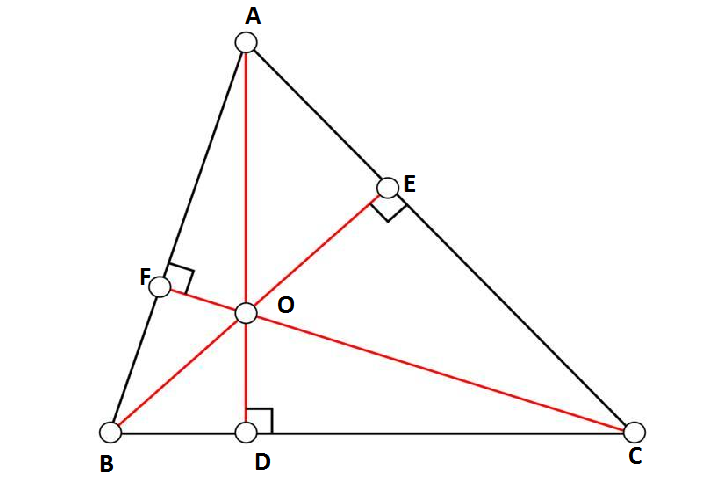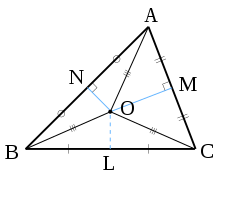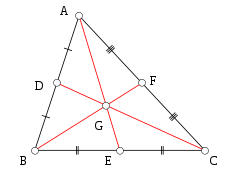
What is the relation between orthocenter, circumcentre, and centroid?
Answer
498k+ views
Hint: First, we shall analyze the given information so that we can able to answer the question. Here, in this question, we are asked to calculate the necessary relation between the orthocenter, the circumcenter, and the centroid of a triangle.
Complete step by step answer:
The orthocenter of a triangle is nothing but the point where all the three altitudes intersect each other (i.e.) it is the point where the perpendicular drawn from the vertices to the opposite sides of the triangle cut each other.

Here the altitudes AD, BE and CF intersect at O. Hence, O is the orthocenter of this triangle.
The circumcenter of a triangle is nothing but the point where the perpendicular bisectors of the sides of the triangle intersect each other (i.e.) it is the point of concurrency of the bisector of the sides.

In the above figure, O is the circumcenter of the triangle.
The centroid of a triangle is nothing but the point where all the three medians of the triangle intersect each other (i.e.) it is the point of intersection of all three medians.

Here the medians AE, BF, and CD intersect at G. Hence, G is the centroid of this triangle.
Here, we are asked to calculate the relation between the orthocenter, circumcenter, and centroid.
Suppose H be the orthocenter, O be the circumcenter and G be the centroid.
Since these three points lie on the same line, these points are said to be the collinear points.
Also, it is a known fact that the centroid divides the orthocenter and the circumcenter internally in the ratio $2:1$
Hence, $\dfrac{{HG}}{{GO}} = 2:1$
Note: From the above explanation, we can understand that when we take an isosceles triangle, the centroid, the orthocenter, and the circumcenter lie on the same line whereas when we take an equilateral triangle, the centroid, the orthocenter, and the circumcenter coincide at a point. This is the required relation between orthocenter, circumcentre, and centroid.
Complete step by step answer:
The orthocenter of a triangle is nothing but the point where all the three altitudes intersect each other (i.e.) it is the point where the perpendicular drawn from the vertices to the opposite sides of the triangle cut each other.

Here the altitudes AD, BE and CF intersect at O. Hence, O is the orthocenter of this triangle.
The circumcenter of a triangle is nothing but the point where the perpendicular bisectors of the sides of the triangle intersect each other (i.e.) it is the point of concurrency of the bisector of the sides.

In the above figure, O is the circumcenter of the triangle.
The centroid of a triangle is nothing but the point where all the three medians of the triangle intersect each other (i.e.) it is the point of intersection of all three medians.

Here the medians AE, BF, and CD intersect at G. Hence, G is the centroid of this triangle.
Here, we are asked to calculate the relation between the orthocenter, circumcenter, and centroid.
Suppose H be the orthocenter, O be the circumcenter and G be the centroid.
Since these three points lie on the same line, these points are said to be the collinear points.
Also, it is a known fact that the centroid divides the orthocenter and the circumcenter internally in the ratio $2:1$
Hence, $\dfrac{{HG}}{{GO}} = 2:1$
Note: From the above explanation, we can understand that when we take an isosceles triangle, the centroid, the orthocenter, and the circumcenter lie on the same line whereas when we take an equilateral triangle, the centroid, the orthocenter, and the circumcenter coincide at a point. This is the required relation between orthocenter, circumcentre, and centroid.
Recently Updated Pages
Two men on either side of the cliff 90m height observe class 10 maths CBSE

What happens to glucose which enters nephron along class 10 biology CBSE

Cutting of the Chinese melon means A The business and class 10 social science CBSE

Write a dialogue with at least ten utterances between class 10 english CBSE

Show an aquatic food chain using the following organisms class 10 biology CBSE

A circle is inscribed in an equilateral triangle and class 10 maths CBSE

Trending doubts
Why is there a time difference of about 5 hours between class 10 social science CBSE

Write a letter to the principal requesting him to grant class 10 english CBSE

What is the median of the first 10 natural numbers class 10 maths CBSE

The Equation xxx + 2 is Satisfied when x is Equal to Class 10 Maths

Which of the following does not have a fundamental class 10 physics CBSE

State and prove converse of BPT Basic Proportionality class 10 maths CBSE




